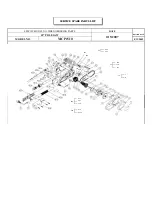
TROUBLESHOOTING GUIDE
WARNING
To avoid injury from an accidental start,
turn the switch OFF and always remove the plug
from the power source before making any adjustments.
PLEASE READ THE FOLLOWING:
The manufacturer
and/or distributor is providing the buyer with a parts list and
assembly diagram in this manual as a reference tool only.
Neither the manufacturer nor distributor make any
representation or warranty of any kind to the buyer regarding
the accuracy of the list or diagram or that buyer is qualified
and able to make any repairs or replace any parts of
the product. The manufacturer and/or distributor expressly
recommend: that all repairs and/or part replacements only
be undertaken by a certified and licensed technician, and not
by the buyer. The buyer assumes all risk and liability, including
injuries to persons and damage to property, associated with
and arising out of any attempt of the buyer at repairs or
replacement of parts to the product.
SYMPTOM
Breaking blades
Blade run out.
Blade not in line
with arm motion.
Motor will
not run.
Excessive
vibration.
NOTE:
There will
always be some
vibration present
when the saw is
running because
of motor
operation.
1. Wrong tension.
2. Overworking blades.
3. Wrong blade application.
4. Twisting blade in wood.
1. Blade holders not aligned.
1. Defective cord or plug.
2. Defective motor.
3. Blown overload breaker.
1. Improper mounting of saw.
2. Unsuitable mounting surface.
3. Loose table or table
resting against motor.
4. Loose motor mounting.
1. Adjust blade tension. See BLADE REMOVAL
AND INSTALLATION section.
2. Reduce feed rate. See BLADE REMOVAL
AND INSTALLATION section.
3. Use narrow blade. See BLADE SELECTION section.
4. Avoid side pressure on blade. See BLADE
REMOVAL AND INSTALLATION section.
1. Loosen blade holder lock screw holding blade holder to
arms. Adjust position of blade holders. Retighten blade
holder lock screw.
See BLADE REMOVAL AND INSTALLATION section.
1. Replace defective parts before using saw again. See
ELECTRICAL REQUIREMENTS AND SAFETY section.
2. Call Service Center. Any attempt to repair this motor
may create a HAZARD unless the repair is done by
a qualified technician.
3. Push the on/off switch to the OFF (O) position.
Let the motor cool. See OPERATION OVERLOAD
BREAKER section.
1. See mounting instructions in this manual for
proper mounting technique.
2. The heavier your workbench is, the less vibration will
occur. A plywood workbench will not be as good a work
surface as the same size solid lumber.
3. Tighten the table lock knob.
4. Tighten motor mounting screw.
POSSIBLE CAUSES
CORRECTIVE ACTION
14
















































